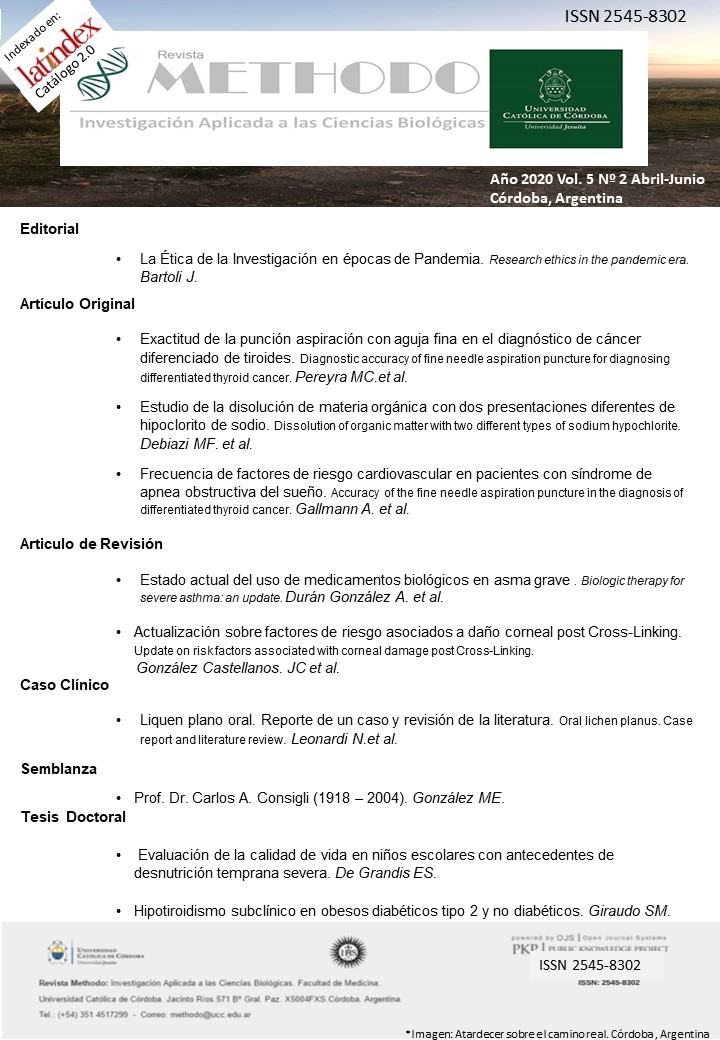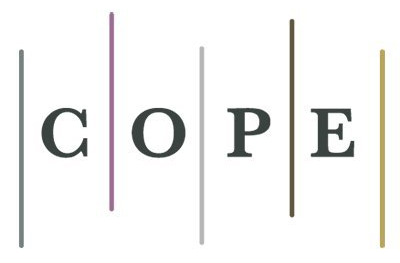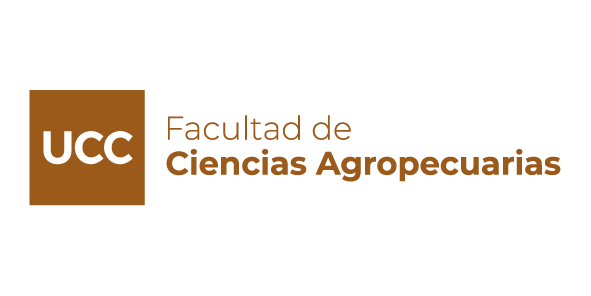Evaluación de la calidad de vida en niños escolares con antecedentes de desnutrición temprana severa
DOI:
https://doi.org/10.22529/Resumen
El presente trabajo evaluó calidad de vida relacionada a la salud (CVRS) en escolares que han sobrevivido a desnutrición severa padecida antes de los 2 años de vida. Material y método. Estudio descriptivo, correlacional, de casos y controles, anidado. La evaluación se efectuó en 53 niños entre 5 y 12 años, de 25 familias; 25 casos con antecedentes de desnutrición severa temprana y 28 controles. Se indagaron antecedentes sociodemográficos. La calidad de vida se valoró con el formulario de calidad de vida pediátrico PedsQL4.0TM. Para analizar diferencias de proporciones se utilizó la prueba de chi cuadrado y en la diferencia de medias, ANOVA. La relación entre variables fue explorada a partir de análisis multivariado con nivel de significación de p < 0,05. Resultados. Los casos fueron 16 mujeres y 9 varones y controles 16 mujeres y 12 varones. En las categorías de NSE la mayoría de las familias estuvieron en el Estrato III (Muy bajo): 20/25 (80%) y 76% de familias tenían creencias religiosas. La escolaridad materna fue principalmente primaria completa (84%). La escolaridad debajo del nivel apropiado para la edad se observó en 5/25 casos (20%) y 7/28 controles (28%). La media de puntaje z de peso actual en los casos fue de -1,36 y de -0,49 en los controles. La media z de talla actual fue en los casos -1,44 y controles -1,33. El puntaje total observado de PedsQL TM fue significativamente menor en los casos. Se observó una media de 80,82 ± 1,94 puntos para casos y 89,18 ±1,84 puntos para controles (p<0,01). El puntaje en dimensión física de PedsQL TM fue significativamente menor en casos que en controles (media de 87,75 ± 3,37 para casos y 94,75 ±1,87 para controles) p< 0,05. Los pacientes con antecedentes de desnutrición mostraron puntaje total más bajo en salud psicosocial que sus controles sanos: media 77,77 ± 2,90 y 86,57 ±1,42 puntos para casos y controles respectivamente (p< 0,05). La dimensión emocional mostró puntaje significativamente menor en los casos comparado con los controles con una media de 67,80 ±4,40 y 78,75 ±2,96 puntos respectivamente (p<0,05). Los pacientes con antecedentes de desnutrición mostraron puntajes significativamente menores que sus controles sanos en dimensión social; las medias de puntuación fueron de 88,80 ±3,05 y 95,71 ±1,52 puntos respectivamente (p<0,05). Los pacientes con antecedentes de desnutrición mostraron puntajes significativamente menores que sus controles en dimensión escolar; las medias fueron 74,58 ± 3,80 y 85,00 ±3,51 puntos para casos y controles respectivamente (p< 0,05).Descargas
Referencias
ODonnell A. Una visión de la problemática nutricional de los niños argentinos. En: ODonnell A, Carmuega E. Salud y calidad de vida de los niños argentinos. Buenos Aires. Publicación CESNI n° 18, 1999: 119-152.
Cravioto J, Cravioto P. Algunas consecuencias psico biológicas a largo plazo de la malnutrición. Anales Nestlé 1993; 48: 55-66.
Eiser C, Morse R. A review of measures of quality of life for children with chronic illness. Arch Dis Child 2001; 84: 205-211. https://doi.org/10.1136/adc.84.3.205
Muldoon M F, Barger S D, Flory J D, Manuck SB. What are quality of life measurements measuring?. BMJ 1998; 316: 542-545. https://doi.org/10.1136/bmj.316.7130.542
Brock D. Medidas de la calidad de vida en el cuidado de la salud y la ética médica. En: Nussbaum M, Sen A. La calidad de vida. México D F. Editorial Fondo de cultura económica, 1996: 135-181.
Guyatt G H, Freeny D H, Patrick D L. Measuring health - related quality of life. Ann Intern Med 1993; 118: 622-629. https://doi.org/10.7326/0003-4819-118-8-199304150-00009
Sanders C, Egger M, Donovan J, Tallon D, Frankel S. Reporting on quality of life in randomised contolled trials: bibliographic study. BMJ 1998; 317: 1191-1194. https://doi.org/10.1136/bmj.317.7167.1191
Jenney M E M, Campbell S. Measuring quality of life. Arch Dis Child 1997; 77: 347-350. https://doi.org/10.1136/adc.77.4.347
Gill T M, Feinstein A R. A Critical appraisal of the quality of life measurements. JAMA 1994; 272: 619-626. https://doi.org/10.1001/jama.1994.03520080061045
Kirshner B, Guyatt G. A methodologic framework for assessing health indices. J Chonic Dis 1985; 38:27-38. https://doi.org/10.1016/0021-9681(85)90005-0
Freeny D, Furlong W, Barr R D. Multiattribute approach to the assessment of health related quality of life. Med Pediatr Oncol 1998 (Suppl 1): 54-59. https://doi.org/10.1002/(SICI)1096-911X(1998)30:1+<54::AID-MPO8>3.3.CO;2-Q
Eiser C. The measurement of health-related quality of life (QOL) in paediatric clinical trials: a systematic review. Health Qual Life Outcomes. 2004; 2: 66. Published online 2004 November 22. https://doi.org/10.1186/1477-7525-2-66
Limbers C, Newman D, Varni JW. Factorial invariance of child self-report across socioeconomic status groups: a multigroup confirmatory factor analysis utilizing the PedsQL™ 4.0 Generic Core Scales. Journal of Behavioral Medicine Volume 31, Number 5, 401-411, https://doi.org/10.1007/s10865-008-9166-3
Stein R E K; Bauman L J, Westbrook L E, Coupey S M, Ireys H T. Framework for identifying children who have chronic conditions. The case for a new definition. J Pediatr 1993; 122: 342-347. https://doi.org/10.1016/S0022-3476(05)83414-6
Starfield B, Bergner M, Ensminger M, Riley R N, Ryan S, Green B, McGauhey P, Skinner A, Kim S. Adolescent health status measurement: Development of the child health and illness profile. Pediatrics 1993; 91: 430-435 https://doi.org/10.1542/peds.91.2.430
Boynton P. Administering, analyzing and reporting your questionnaire. BMJ 2004; 328: 1372-1375. https://doi.org/10.1136/bmj.328.7452.1372
Schünemann H, Sperati F, Barba M, Santesso N, Melegari C, Akl E, Guyatt G, Muti P. An instrument to assess quality of life in relation to nutrition: item generation, item reduction and initial validation. Health and Quality of Life Outcomes 2010, 8:26. https://doi.org/10.1186/1477-7525-8-26
Varni J, Limbers C, Burwinkle T. Parent proxy-report of their children's health related quality of life. Health and Quality of Life Outcomes 2007; 5:2. https://doi.org/10.1186/1477-7525-5-2
Saigal S, Rosenbaum P, Stoskopt B, Hault L, Furlong P. Heath utilities Index Mark 2Pane S, Solans M, Gaite L, Serra-Sutton V, Estrada MD, Rajmil L. Instrumentos de calidad de vida relacionada con la salud en la edad pediátrica. Revisión sistemática de la literatura: actualización. Agencia d'Avaluació de Tecnología i Recerca Mediques. Barcelona, enero de 2006
Varni J, Seid M, Kurtin P. PedsQL(TM) 4.0: Reliability and Validity of the Pediatric Quality of Life Inventory(TM) Version 4.0 Generic Core Scales in Healthy and Patient Populations. Med Care 2001; 39: 800-812 https://doi.org/10.1097/00005650-200108000-00006
Varni JW, Limbers C, Burwinkle T. How young can children reliably and validly self- report their health-related quality of life? An analysis of 8,591 children across age subgroups with the PedsQL™ 4.0 Generic Core Scales. Health and Quality of Life Outcomes 2007, 5:1 https://doi.org/10.1186/1477-7525-5-1
Roizen M, Rodríguez S, Bauer G, Medin G, Bevilacqua S, Varni J, Dussel V. Initial validation of the Argentinean Spanish version of the PedsQL™ 4.0 Generic Core Scale in children and adolescents with chronic diseases: acceptability and comprehensibility in low income settings. https://doi.org/10.1186/1477-7525-6-59
Varni JW, Seid M, Rode C. The PedsQL™: Measurement Model for the Pediatric Quality of Life Inventory. Medical Care, 1999; 37(2):126-139 https://doi.org/10.1097/00005650-199902000-00003
Varni J, Burwinkle T, Lane M. Health related quality of life measurement in pediatric clinical practice. An appraisal and precept for future research and application. Health and Quality of Life Outcomes 2005, 3:34:1-9 https://doi.org/10.1186/1477-7525-3-34
Varni, J.W, Seid M, Kurtin P. The PedsQL™ 4.0: Reliability and validity of the Pediatric Quality of Life Inventory™ Version 4.0 Generic Core Scales in healthy and patient populations. Medical Care, 2001; 39(8): 800-812. https://doi.org/10.1097/00005650-200108000-00006
Varni J, Burwinkle T, Berrin S, Sherman S, Artavia K, Malcarne V, Chambers H. The PedsQL in pediatric cerebral palsy: reliability, validity, and sensitivity of the Generic Core Scales and Cerebral Palsy Module. Develop Med Child Neurology 2006; 48: 442-449 doi:10.1017/S001216220600096X
https://doi.org/10.1017/S001216220600096X
Varni J, Burwinkle T, Sherman S, Kanela Hanna, Susan J Berrin, Vanessa L Malcarne and Henry G Chambers. Health-related quality of life of children and adolescents with cerebral palsy: hearing the voices of the children. Developl Med amp; Child Neurol 2005, 47: 592 597 https://doi.org/10.1017/S0012162205001179
Varni J W, Limbers C, Burwinkle.Impaired health-related quality of life in children and adolescents with chronic conditions: a comparative analysis of 10 disease clusters and 33 disease categories/severities utilizing the PedsQL™ 4.0 Generic Core Scales. Health and Quality of Life Outcomes 2007, 5:43 https://doi.org/10.1186/1477-7525-5-43
Waterlow J C. Malnutrición proteico energética. Washington D C. OPS, 1996.
Galler J R, Shumsky J S; Morgane P J. Malnutrition and brain development. In: Walker W A, Watkins J B. Nutrition in pediatrics. London. B C Publisher, 1997:196-212.
Bhan M K, Bhandari N, Balh R. Management of the severely malnourished child: perspective from developing countries. BMJ 2003; 326: 146- 151. https://doi.org/10.1136/bmj.326.7381.146
Calvo E, Longo E. Encuesta antropométrica en menores de 6 años bajo Programa Materno Infantil. Departamento de Nutrición. Dirección de Salud Materno Infantil. Ministerio de Salud y Acción Social. En: Estudios antropométricos en la población infanto - juvenil. República Argentina 1993 - 1996.
CLACYD. Iniquidad y desarrollo infantil -0 a 2 años - Publicación n° 6. Córdoba 2002: 30-63.
Encuesta nacional de Nutrición y Salud (ENNyS). Disponible en: http/www.msal.org.ar
Hertzig M E, Birchtt G, Richardson S A. Intellectual levels of school children severely malnourished during the first two years of life. Pediatrics 1972; 49: 814-824 https://doi.org/10.1542/peds.49.6.814
Rudolf M, Logan S. What is the long term outcome for children who fail to thrive? A systematic review- Arch Dis Child 2005;90:925-931. https://doi.org/10.1136/adc.2004.050179
Cravioto J, DeLicardie E. Nutrition and behavior and learning. In: Karger, Basel. Food Nutrition and Health: World Review of Nutrition and Dietetics. Washington, Rechcigl Ed, 1973: 80-96. https://doi.org/10.1159/000393588
Emond,A, Blair P, Emmett P, Drewett R. Weight Faltering in Infancy and IQ Levels at 8 Years in the Avon Longitudinal Study of Parents and Children. Pediatrics 2007 120: e1051-e1058 https://doi.org/10.1542/peds.2006-2295
Alaimo K, Olson C, Frongillo E. Food insufficiency and American school - aged children's cognitive, academic, and psychosocial development. Pediatrics 2001; 108: 44 53. https://doi.org/10.1542/peds.108.1.44
Fairchild M W, Haas J D, Habicht J P. Iron deficiency and behavior: Criteria for testing causality. Am J Clin Nutr 1989; 50: 566- 574. https://doi.org/10.1093/ajcn/50.3.566
Hallberg L. Searh for nutritional confounding factors in the relationship between iron deficiency and brain function. Am J Clin Nutr 1989; 50: 598-608. https://doi.org/10.1093/ajcn/50.3.598
Isaacs E, Gadian D, Sabatini S, Chong W, Quinn B, Fischl B, Lucas A. the effect of human diet on caudate volumes and IQ. Ped Res 2008; 63:308-314 https://doi.org/10.1203/PDR.0b013e318163a271
Hüppi P. Nutrition for the brain. Pediatr Res2008,63(3):229-231
https://doi.org/10.1203/PDR.0b013e318168c6d1
Galler J R, Barret L R. Children and famine: long - term impact on development. Ambul Child Health 2001; 7: 85-95. https://doi.org/10.1046/j.1467-0658.2001.00109.x
McGuffin P, Martin N. Behavior and genes. BMJ 1999; 319: 37-40. https://doi.org/10.1136/bmj.319.7201.37
Horowitz F D. Using developmental theory to guide the search for the effects of biological risk factors on the development of children. Am J Clin Nutr 1989; 50: 589-597. https://doi.org/10.1093/ajcn/50.3.589
Galler J R, Ramsey F, Salt P, Forde V. Long term effects of early kwashiorkor compared to maramus II. Intellectual performance. J Pediatr Gastroenterol Nutr 1987; 6: 847-854. https://doi.org/10.1002/j.1536-4801.1987.tb09423.x
Frank D A, Zeisel S. Failure to thrive. Pediatr Clin North Am 1988; 35: 1187-1205. https://doi.org/10.1016/S0031-3955(16)36578-6
McCally M, Haines A, Fein O, Addington W, Lawrence R, Cassel C. Poverty and ill health. Med Pub Issues 1998; 129: 726-733. https://doi.org/10.7326/0003-4819-129-9-199811010-00009
Baxter-Jones A D G, Cardy A H, Helms P J, Philips D O, Smith W C S. Influence of socioeconomic conditions on growth in infancy: the 1921 Aberdeen birth cohort. Arch Dis Child 1999; 81: 5-9. https://doi.org/10.1136/adc.81.1.5
Servili C, Medhin G, Hanlon C, Tomlinson M , Worku B, Baheretibeb Y, Dewey M, Alem A, Prince M. Maternal common mental disorders and infant development in Ethiopia: the P-MaMiE Birth Cohort. BMC Public Health 2010, 10:693 https://doi.org/10.1186/1471-2458-10-693
Youdim M B H, Ben-Sachar B, Yehuda S. Putative biological mechanism of the effect of iron deficiency on brain biochemistry and behavior. Am J Clin Nutr 1989; 50: 607-617. https://doi.org/10.1093/ajcn/50.3.607
Walter T, De Andrada I, Chadud P. Iron deficiency anemia : Adverse effects on infant psychomotor development. Pediatrics 1989; 84: 7-17. https://doi.org/10.1542/peds.84.1.7
Lozoff B, Junenez E, Wolf A W. Long-term developmental outcome of infants with iron deficiency. N Engl J Med 1991; 325: 687-694. https://doi.org/10.1056/NEJM199109053251004
Pollit E. Iron deficiency and cognitive function. Ann Rev Nutr 1993; 13:521-537 https://doi.org/10.1146/annurev.nu.13.070193.002513
Baker R, Greer F. Clinical Report--Diagnosis and Prevention of Iron Deficiency and Iron- Deficiency Anemia in Infants and Young Children (0-3 Years of Age) Pediatrics 2010 October 5. https://doi.org/10.1542/peds.2010-2576
Wilensky D S, Ginsberg G, Altman M, Tulchinsky T H, Ben Yishay F, Auerbach J. A community based study of failure to thrive in Israel. Arch Dis Child 1996; 75:145-148. https://doi.org/10.1136/adc.75.2.145
Blackburn C, Spencer N, Read J. Prevalence of childhood disability and the characteristics and circumstances of disabled children in the UK: secondary analysis of the family Resources Survey. BMC Pediatrics 2010; 10: 21. https://doi.org/10.1186/1471-2431-10-21
Koruk I, Simsek Z, Koruk S, Doni N, Gürses C. Intestinal parasites, nutritional status and psychomotor development delay in migratory farm worker's children. Child: Care, Health Develop2010; 36: 888-894. https://doi.org/10.1111/j.1365-2214.2010.01126.x
Waterlow JC. Classification and definition of protein calorie malnutrition. Brit Med J 1972: 566-569 https://doi.org/10.1136/bmj.3.5826.566
Block R, Krebs N and the Committee on Child Abuse and Neglect and the Committee on Nutrition. Failure to Thrive as a Manifestation of Child Neglect. Pediatrics, Nov 2005; 116: 1234 -1237. https://doi.org/10.1542/peds.2005-2032
Engle P, Black M, Behrgman B, Cabral de Melo M, Gertier P, Kapiriri L, Martorelli R, Young E. Strategies to avoid the loss of developmental potential in more than 200 million children in the developing world. The lancet 2007; 369:229-242 https://doi.org/10.1016/S0140-6736(07)60112-3
OBrien L, Gardner Heycock E, Hanna M, Watts Jones P, Cox JL. Postnatal depression and faltering growth: A Community study. Pediatrics 2004;113:1242-1247 https://doi.org/10.1542/peds.113.5.1242
Wasserman G, Liu X, Litvak P, Gardner J, Graciano J. Developmental impacts of heavy metals and under nutrition. J Compilation Nordic Pharm Society. Basic Clin Pharmacol Toxicol 2008 102: 212-217 https://doi.org/10.1111/j.1742-7843.2007.00187.x
Agarwal D K, Upadhyay S K, Agarwal K N. Influence of malnutrition on cognitive development assessed by piagetian task. Acta Pediatr Scand 1989; 78: 115-122. https://doi.org/10.1111/j.1651-2227.1989.tb10897.x
Grantham-McGregor S M, Schofield W, Harris L. Effect of psychosocial stimulation on mental development of severely malnourished children: an interin report. Pediatrics 1983; 72: 239-243. https://doi.org/10.1542/peds.72.2.239
World Health Organization. Management of Severe malnutrition: A Manual for phisicians and other senior health workers. Geneva: WHO 1999.
Pawelek I, Dokoipul K, Koletzko B. Prevalence of malnutrition in paediatrics hospital patients. Clin Nutrition 2008; 27:72-76. https://doi.org/10.1016/j.clnu.2007.11.001
Benoit D, Coolbear J. Disorders of attachment and failure to thrive in: Atkinson L, Goldberg S. Attachment Issues in Psychopathology and Intervention. Ed Taylor and Francis e-Library New Jersey 2008: 49-59
Frank D, Zeisel S. Failure to thrive. Ped Clin North Am 1988;35:1187-1206 https://doi.org/10.1016/S0031-3955(16)36578-6
Grantham-McGregor S M, Schofield W, Powell C. Development of severely malnourished children who received psychosocial stimulation: six-year follow-up. Pediatrics 1987; 79:247-254. https://doi.org/10.1542/peds.79.2.247
Evans D, Bowie M D, Hansen J D L; Moodie A D, van der Spuy H I J. Intellectual development and nutrition. J Pediatr 1980: 358-362. https://doi.org/10.1016/S0022-3476(80)80181-8
Galler J R; Ramsey F, Morley D S, Archer E. The long-term effects of early kwashiorkor compared with marasmus IV. Performance on the national higth school entrance examination.Pediatr Res 1990; 28:235-239. https://doi.org/10.1203/00006450-199009000-00018
Winick M, Rosso P. Head circunference and cellular growth of the brain in normal and marasmic children. J Pediatr 1969; 74:774-778. https://doi.org/10.1016/S0022-3476(69)80140-X
Galler J R, Ramsey F, Salt P, Archer E. Long-term effects of early kwashiorkor compared with marasmus III. Fine motor skills. J Pediatr Gastroenterol Nutr 1987; 6: 855-959. https://doi.org/10.1002/j.1536-4801.1987.tb09424.x
Gorman K, Pollitt E. Does schooling buffer the effects of early risk? Child Develop 1996; 67:314-326. https://doi.org/10.1111/j.1467-8624.1996.tb01736.x
Wachs T D. Relation of mild to moderate malnutrition to human development: Correlational studies. J Nutr 1995; 125: 2245S-2254S. https://doi.org/10.1093/jn/125.suppl_8.2245S
Chase P H, Martin H P. Under nutrition and child development. New Engl J Med 1970; 282:933-976. https://doi.org/10.1056/NEJM197004232821701
Chase P H, Welch N N, Dabiere C S. Alterations in human brain biochemistry following intrauterine growth retardation. Pediatrics 1972; 50:403-411. https://doi.org/10.1542/peds.50.3.403
Dobbing J, Sand J. The quantitative growth and development of the infant brain. Arch Dis Child 1973; 48: 757-767.
https://doi.org/10.1136/adc.48.10.757
Williams C. Food for thought. Brain, genes and nutrition. Brain Res 2008; 1237: 1-4. https://doi.org/10.1016/j.brainres.2008.09.039
Pogribny I , Karpf A, James S, Melnyk S, Han T. Epigenetic alterations in the brain of Fisher 344 rats induced by long term administration of folate methyl deficient diet. Brain Res 2008; 1237: 25-34. https://doi.org/10.1016/j.brainres.2008.07.007
Mc Gowan P, Meaney M, Szyf M. Diet and the epigenetic programming of phenothipic differences in behavior. Brain Res 2008; 1237: 12-24. https://doi.org/10.1016/j.brainres.2008.07.074
Bartel P R, Griesel R D, Freiman I, Rosen E, Geefhuysen J. Long-term effects of kwashiorkor on the electroencephalogram. Am J Clin Nutr 1979; 32:753-757. https://doi.org/10.1093/ajcn/32.4.753
Barnet A B, Weiss J P, Sotillo M V. Abnormal auditory evoked potentials in early infancy malnutrition. Science 1978; 201: 450-452. https://doi.org/10.1126/science.96529
Monckeberg F, Tisler S, Toro S. Malnutrition and mental development. Am J Clin Nutr 1972; 25: 766-772. https://doi.org/10.1093/ajcn/25.8.766
Cabak V, Najdavic R. Effect of under nutrition in early life on physical and mental development. Arch Dis Child 1965; 40:532-534. https://doi.org/10.1136/adc.40.213.532
Glaser H H, Heagarty M C, Bullard D M. Physical and psychological development of children with early failure to thrive. J Pediatr 1968; 73: 690-698. https://doi.org/10.1016/S0022-3476(68)80174-X
Innis S. Dietary omega 3 fatty acids and the developing brain. Brain Res 2008; 1237: 35 43. https://doi.org/10.1016/j.brainres.2008.08.078
Lloyd Still J D, Hurwitz I, Wolff P, Shwachman C. Intellectual development after severe malnutrition in infancy. Pediatrics 1974; 54: 306-311 https://doi.org/10.1542/peds.54.3.306
Management of severe malnutrition: a manual for physicians and others senior heath workers. World Health Organization. Geneva. 1999
Bilukha O, Talley L. Impact of new WHO growth standards on the prevalence of acute malnutrition and operations of Feeding Programs Darfur, Sudan, 2005-2007. JAMA. 2009; 302(5):484-485. Disponible en: http://jama.ama-assn.org/cgi/content/full/302/5/484
WHO Anthro for personal computers, version 3.1, 2010: Software for assessing growth and development of the world's children. Geneva: WHO, 2010 Disponible en: http://www.who.int/childgrowth/software/en/
Van den Broeck J, Willie D, Younger N. The World Health Organization child growth standards: expected implications for clinical and epidemiological research. Eur J Pediatr 2009; 168:247-251- https://doi.org/10.1007/s00431-008-0796-9
Lapidus N, Luquero FJ, Gaboulaud V, Shepherd S, Grais RF. Prognostic accuracy of WHO growth standards to predict mortality in a large-scale nutritional program in Niger. PLoS Med 2009; 6(3): e1000039. https://doi.org/10.1371/journal.pmed.1000039
CESNI. Proyecto Tierra del Fuego. Diagnóstico basal de salud y nutrición. Buenos Aires. Edición Fundación Jorge Macri 1995:28-34
Chesta M, Lobo B, Agrelo F, Carmuega E, Sabulski J, Durán P, Pascual L. Evaluación antropométrica en niños de la ciudad de Córdoba. Año 2000. Arch Arg Pediatr 2007,105: 101-108
Cravioto J, DeLicardie E, Birch H. Nutrition, growth and neurointegrative development: An experimental and ecologic study. Pediatrics 1966; 38: 319-320 https://doi.org/10.1542/peds.38.2.319
Reyes H, Perez Cuevas R, Sandoval A, Castillo R, Santos J, Doubova S, Gutierrez G. The family as a determinant of stunting in children living in conditions of extreme poverty: a case control study. BMC Public health 2004; 4:57 https://doi.org/10.1186/1471-2458-4-57
Dykman R, Casey P, Ackerman P, McPherson W. Behavioral and Cognitive Status in School-Aged Children with a History of Failure to Thrive During Early Childhood. Clin Pediatr 2001 vol. 40 no. 2 63-70. https://doi.org/10.1177/000992280104000201
Mohsena M, Mascie-Taylor CG, Goto R. Association between socio-economic status and childhood under nutrition in Bangladesh; a comparison of possession score and poverty index. Public doi:10.1017/S1368980010001758 Health Nutrition: 13(10), 1498-1504 https://doi.org/10.1017/S1368980010001758
Apaz, M T. Calidad de Vida en niños con Artritis Idiopática Juvenil. Trabajo de Tesis Doctoral. Universidad Católica de Córdoba. 2008
Chida Y, Steptoe A, Powel L. Religiosity/Spirituality and mortality. Psicother Psichosom2009; 78: 81-90. https://doi.org/10.1159/000190791
Cotton S, Kudel I, Roberts Y, Pallerla H, Tsevat J, Succop P, Yi M. Spiritual Well- Being and Mental Health Outcomes in Adolescents With or Without Inflammatory Bowel Disease. J Adolesc Health. doi:10.1016/j.jadohealth.2008.09.013. 2009 May; 44(5): 485-492. https://doi.org/10.1016/j.jadohealth.2008.09.013
Matthews D. Oración y espiritualidad. Rheumatic Disease clinic of North America (Edición Española) 2000;2: 181-191
Cotton S, Grossoehme D, Rosenthal S, McGrady, Roberts Y, Hines J, Yi M, Tsevat J. Religious/Spiritual Coping in Adolescents with Sickle Cell Disease: A Pilot Study. J Pediatr Hematol Oncol. 2009 May; 31(5): 313-318. https://doi.org/10.1097/MPH.0b013e31819e40e3
Sameroff, A. J., Seifer, R., Baldwin, A. and Baldwin, C. (1993), Stability of Intelligence from Preschool to Adolescence: The Influence of Social and Family Risk Factors. Child Development, 64: 80-97. https://doi.org/10.1111/j.1467-8624.1993.tb02896.x
Rezzónico C. Evaluación de la diarrea crónica en niños desnutridos. Revista Argentina de Pediatría 1979; V: 11-18
Saloojee H. Tackling Moderate Malnutrition: The Next Frontier. J Pediatr Gastroenterol Nutr 2004; 38(2): 143-145
https://doi.org/10.1002/j.1536-4801.2004.tb12131.x
Gilbert M, Mc Phail R, Baldwin J, Moser V, Chernoff N. Moderate developmental under nutrition: Impact on growth and cognitive function in youth and old age. Neurot Teratol 2010; 32: 362-372. https://doi.org/10.1016/j.ntt.2009.12.008
Ranade S, Rose A, Rao M, Gallego, Gressens P, Mani S. Different types of nutritional deficiencies affect different domains of spatial memory function checked in a radial arm maze. Neuroscience 2008; 152:859-866 https://doi.org/10.1016/j.neuroscience.2008.01.002
Grosse S, Roy K. Long term economic effect of early childhood nutrition. The Lancet 2008;371: 365-366
https://doi.org/10.1016/S0140-6736(08)60180-4
Martorell R, Melgar P, Maluccio J, Stein A, Rivera J. The Nutrition Intervention Improved Adult Human Capital and Economic Productivity J. Nutr. 2010; 140: 411-414. https://doi.org/10.3945/jn.109.114504
Behrman J, Hoddinott J, Maluccio J, Soler Hampejsck E, Behrmen E, Martorell R, Ramirez Zea M, Stein A. What determines adult cognitive skills? Experiences in Guatemala. PARC Working Paper Series. IFPRI Discussion Paper 00826. 2008
WHO child growth standards and the identification of severe acute malnutrition in infants and children. A joint statement by the United Nations Children's Fund 2007;334:733-744
ODonnell A, Britos S. Reflexiones y propuestas en la emergencia alimentaria. Arch Argent Pediatr 2002; 100: 1-5
Gomila AA, De Grandis ES, Visconti G, Montero S, Bertero M, Marietti G, Crespo D, Pico A, Bianchi M, Gomila A. Estado nutricional en niños internados en Salas de Cuidados Mínimos. Hospital de Niños de la Santísima Trinidad. Córdoba. Arch Argent Pediatr 2009; 107(1):37-42
Yip R, Scanlon K. The burden of malnutrition: A population perspective. J Nutr. 1994;124: 2043S-2046S
https://doi.org/10.1093/jn/124.suppl_10.2043S
Monga M, Walia B, Gandhi A, Chandra J, Sharma S. Effect of iron deficiency on evoked potential in growing children. Brain Develop 2010; 32: 213-216. https://doi.org/10.1016/j.braindev.2009.02.009
Klatchoian D., Len C, Terreri M, Silva M, Itamoto C, Ciconelli R. Quality of life of children and adolescents from Sao Paulo: reliability and validity of the Brazilian version of the Pediatric Quality of Life Inventory TM version 4.0 Generic Core Scales. J. Pediatr. (Rio J.) 2008; 84(4): 308-315. https://doi.org/10.1590/S0021-75572008000400005
Quittner A, Buu A, Messer M, Modi A, Watrous M. Development and Validation of the Cystic Fibrosis Questionnaire in the United States A Health-Related Quality-of-Life Measure for Cystic Fibrosis. Chest 2005; 128; 2347-2354. https://doi.org/10.1378/chest.128.4.2347
van Koppen E, Schweizer J, Csizmadia C, Krom Y, Hylkema H, van Geel A, Koopman H, Verloove-Vanhorick S, Mearin M. Long-term Health and Quality-of-Life Consequences of Mass Screening for Childhood Celiac Disease: A 10-Year Follow-up Study. Pediatrics 2009;123 : e582-e588 https://doi.org/10.1542/peds.2008-2221
Carlon S, Shields N, Yong K, Gilmore R, Sakzewski L, Boyd R. A systematic review of the psychometric properties of Quality of Life measures for school aged children with cerebral palsy.BMC Pediatrics 2010, 10:81 https://doi.org/10.1186/1471-2431-10-81
Adair C, Marcoux G, Bischoff T, Cram B, Ewashen C, Pinzon J, Gusella J, Geller J, Scattolon Y, Fergusson P, Styles L, Brown K. Responsiveness of the Eating Disorders Quality of Life Scale (EDQLS) in a longitudinal multi-site sample. HQLO 2010; 8:83. https://doi.org/10.1186/1477-7525-8-83
Barakat L, Marmer P, Schwartz L. Quality of life of adolescents with cancer: family risks and resources. HQLO 2010, 8:63 https://doi.org/10.1186/1477-7525-8-63
Kleinman R, Murphy M, Little M, Pagano M, Wehler C, Regal K, Jellinek M. Hunger in children in the United States: Potential behavioral and emotional correlates. Pediatrics 1998;101(1). https://doi.org/10.1542/peds.101.1.e3
Ammaniti M, Ambruzzi,A, Lucarelli L, Cimino S, D'Olimpio F. Malnutrition and dysfunctional mother-child feeding interactions: Clinical assessment and research implications J Am Coll Nutr 2004; 23:259-271 https://doi.org/10.1080/07315724.2004.10719369
Drewett R, Corbett S, Wright C. Psychical and emotional development, appetite and body image in adolescents who failed to thrive as infants. J Child Psychol Psychiatr 2006;47:524-531 https://doi.org/10.1111/j.1469-7610.2005.01529.x
Gillberg C, Soderstom H. Learning disability. The Lancet 2003, 362: 811-821. https://doi.org/10.1016/S0140-6736(03)14275-4
Ivanovic D, Rodríguez M, Perez H, Alvear J, Diaz M, Leyton B, Almagia A, Toro T, Urrutia M, Ivanovic R. Twelve-years follow-up study of the impact of nutritional status at the onset of elementary school on later educational situation of Chilean school -aged children. Europ J Clin Nutr 2008:62: 18-31 https://doi.org/10.1038/sj.ejcn.1602672
Best evidence statement. Failure to thrive treatment protocol. National Guideline Clearinghouse. Guideline Summary NGC-7302. Disponible en: www.hhs.gov
Love J, Eliason Kisker E, Ross C. The Effectiveness of Early Head Start for 3-Year-Old Children and Their Parents: Lessons for Policy and Programs. Developmental Psychology 2005, Vol. 41, No. 6, 885-901. https://doi.org/10.1037/0012-1649.41.6.885
Black M, Dubowitz H, Krishnakumar A, Starr R Jr. Early intervention and recovery among children with failure to thrive: Follow-up at Age 8. Pediatrics 2007;120;59-69. https://doi.org/10.1542/peds.2006-1657
Grantham-Mc Gregor S, Cheung Y, Cueto S, Glewwe P, Strupp B. Developmental potential in the first 5 years for children in developing countries. The Lancet 2007;369:60- 70 https://doi.org/10.1016/S0140-6736(07)60032-4
Gakidou E, Oza S, Vidal Fuertes C, Li A, Lee D, Souza A, Hogan M, Vander Hoom S, Ezzati M. Improving child survival through environmental and nutritional interventions. JAMA 2007; 298(16): 1876-1887 https://doi.org/10.1001/jama.298.16.1876
Las Metas del Milenio. Disponible en: http://.millenniumindicators.un.org/unsd/mdg/Default.aspx
Sguassero Y, de Onis M, Carroli G. Administración de suplementos alimentarios basada en la comunidad para la promoción del crecimiento de niños pequeños en países en vías de desarrollo (Revisión Cochrane traducida). En: La Biblioteca Cochrane Plus, 2008 Número 4. Oxford: Update Software Ltd. Disponible en: http://www.update-software.com. (Traducida de The Cochrane Library, 2008 Issue 3. Chichester, UK: John Wiley & Sons, Ltd.).
Saha, K. K., Tofail, F., Frongillo, E. A., Rasmussen, K. M., Arifeen, S. E., Persson, L. Á., Huda, S. N. and Hamadani, J. D. (2010), Household food security is associated with early childhood language development: results from a longitudinal study in rural Bangladesh. Child: Care, Health and Development, 36: 309-316. https://doi.org/10.1111/j.1365-2214.2009.01049.x
Alderman H. What do we want to know about the relationship of wealth or income to nutrition? Pub Health Nutr 2010; 13: 1485-1486. https://doi.org/10.1017/S1368980010001229
Boletín CEPAL Desafíos n° 2: Desnutrición infantil en América latina y el Caribe. Número 2, abril de 2006. ISSN 1816-7527. Disponible en: www.cepal.org/desafios
Hill S, Kirkwood B, Edmond K. Prácticas familiares y comunitarias que promueven la supervivencia el crecimiento y el desarrollo del niño. Evidencia en las intervenciones. Washington DC: OPS 2005
Seal A. operational implications of using 2006 World Health Organization growth standards in nutrition programs: secondary data analysis. BMJ. https://doi.org/10.1136/bmj.39101.664109.AE
Joosten K, Meyer R. Nutritional screening and guidelines for managing the child with faltering growth. Eur J Clin Nutr 2010; 64: S22-S24 https://doi.org/10.1038/ejcn.2010.44
Ashworth A. Treatment of severe malnutrition. J Pediatr Gastroenterol Nutr 2001; 32: 516-518. https://doi.org/10.1002/j.1536-4801.2001.tb07364.x
Wright C. Identification and management of failure to thrive. A community perspective. Arch Dis Child 1999; 81: 5-9. https://doi.org/10.1136/adc.82.1.5
Panpanich R, Garner P. Growth monitoring in children. Cochrane Database of Systematic Review. doi:10.1002/14651858.CD.0011443.pub1












